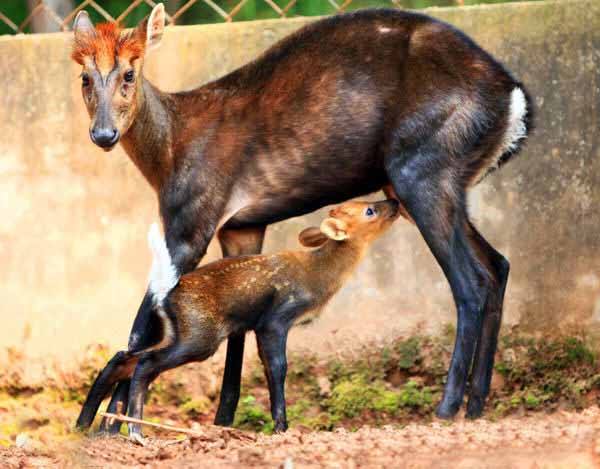Muntiacus crinifrons
IUCN
LCBasic Information
Scientific classification
- name:Muntiacus crinifrons
- Scientific Name:Muntiacus crinifrons,Black fronted Muntjac,Black and gold muntjac, shaggy muntjac, red-headed muntjac, muntjac, green muntjac
- Outline:Ungulata
- Family:Artiodactyls Ruminantia Cervidae Muntiacinae Muntjac
Vital signs
- length:100-110cm
- Weight:21-26kg
- lifetime:10-11years
Feature
The "Black Gold Noble" among Muntjacs
Distribution and Habitat
The black muntjac is a Chinese endemic animal with no subspecies differentiation. Its distribution range is very narrow, limited to southern Anhui, western Zhejiang, Huaiyuan in eastern Jiangxi, and Wuyi Mountain in northern Fujian. It is endemic to China, including: Tonglu, Anji, Yuhang, Lin'an, Fuyang, Zhuji, Jiande, Chun'an, Dongyang, Jinhua, Kaihua, Changshan, Quzhou, Suichang, Wuyi, Jinyun, Longquan, Qingyuan, Taishun and other counties in Zhejiang, occasionally seen in Linhai County; Guangde, Ningguo, Jingxian, Qingyang, Guichi, Shitai, Taiping, Jingde, Jixi, Shexian, Xiuning, Yixian, Qimen, Dongzhi and other counties in Anhui; Wuyuan and Yushan counties in Jiangxi; Pucheng County in Fujian. The entire distribution area covers 39 counties in 4 provinces, with an area of about 76,500 square kilometers.
It mainly inhabits mountain evergreen broad-leaved forests, mixed evergreen and deciduous broad-leaved forests, and shrubs at an altitude of about 1,000 meters, which
Appearance
The black muntjac is the largest species among muntjacs. The body length is 100-110 cm, the ear length is 80-98 mm, the tail length is 20-40 mm, the hind leg length is 230-285 mm, and the total skull length is 132-147 mm. The shoulder height is about 60 cm, and the weight is 21-26 kg. The face length from the tip of the snout to the preorbital area is 64-70 mm, which is generally shorter than 1/2 of the total skull length. The skull is short, the snout is narrow, the nasal bone is long and straight (44-46 mm long), and its widest part is in the front. The lacrimal bone is rectangular in shape, which is opposite to that of the forest musk deer, that is, most of them are longer than wide (17-22 mm long, 16.5-18.5 mm wide), and only a few are similar in length and width.
The black muntjac has dark brown upper body in winter; the brown content of summer hair increases. The male has horns, the horn handle is longer, and there is a tuft of brown crested hair up to 5-7 cm on the top of the
Details
Black fronted Muntjac is a larger species of muntjac, and its appearance is very similar to the Gongshan Muntjac distributed in western Yunnan and Myanmar.

Black muntjacs are timid and cowardly, with a strong sense of fear. They are mostly active in the morning and evening. During the day, they often rest under the roots of large trees or in stone caves. They immediately run into the bushes and hide at the slightest noise. They have a relatively fixed route when they move in steep places, often trampling out a 16-20 cm wide trail, but there is no fixed route in flat places. Generally, males and females live together in pairs, and their activities are relatively hidden. They are territorial and usually move within their territory. They also have amazing swimming skills. In early spring, black muntjacs often look for tender grass in the thatch; in summer, they live in the forests with higher terrain, often on shady slopes or near water sources, and occasionally on alpine meadows; in winter, they migrate downwards, and when snow accumulates, they are forced to move down to the farmland near the slopes, and mostly move on sunny slopes. Black muntjacs have the habit of wandering and foraging, foraging back and forth within a certain range until they are full.
There are two distribution centers of wild black muntjacs, one in southern Anhui and the other in western Zhejiang, with a total of only 5,000 to 6,000. Nature reserves such as Qingliang Peak, Guniujiang, Jiulong Mountain, and Fengyang Mountain have been established in these two central areas.
The main endangered factors of the black muntjac are: the distribution area is shrinking, the population has also declined; poaching is serious; the female-mediated gene flow caused by habitat fragmentation is reduced.
Listed as a national key protected animal level: first level.
Listed in the World Conservation Union (IUCN): vulnerable.
Listed in the Convention on International Trade in Endangered Species of Fauna and Flora (CITES): Appendix I.
Protect wild animals and stop eating game.
Maintaining ecological balance is everyone's responsibility!








